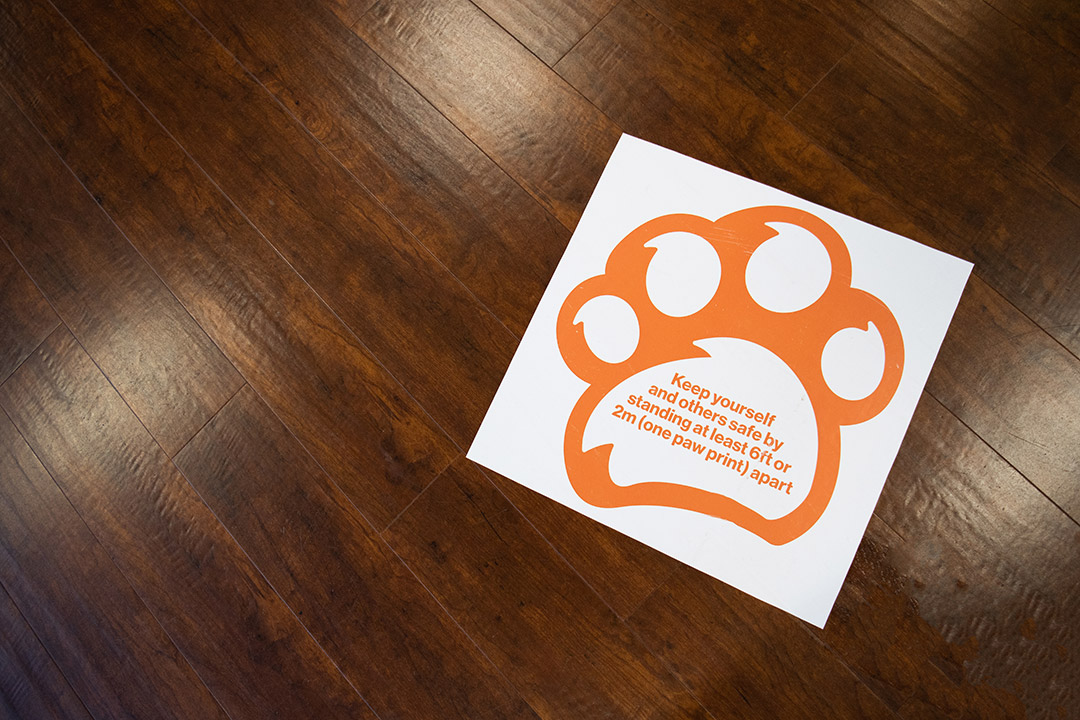Community accountability helps campus navigate pandemic
Gabrielle Plucknette-DeVito
Following posted signage is one way to prevent the spread of COVID-19.
You know the deal. You wash your hands, wear a mask, and stay physically distant. But what happens when you witness someone who isn’t being as COVID-careful as they should be, or see something that conflicts with the protocols and community expectations outlined in the RIT Ready plan aimed at preventing the spread of coronavirus?
An online COVID Violation Reporting Form went live just over a month ago to afford faculty, staff, and students the opportunity to officially log concerns they feel should be addressed. But don’t mistake it for Tiger tattletale-ing. Community accountability has become a cornerstone of navigating the pandemic successfully.
“It is great to see the vast majority of people on campus doing what they are supposed to do,” said Associate Vice President of Student Affairs Nicole Boulais, who was originally tapped to co-chair RIT’s community readiness committee before being thrust into a whole new ballgame following the coronavirus outbreak. “However, when someone does something wrong, reporting it can get a little tricky due to all the new guidelines. That is why the accountability process is concentrated more on education, and less on punitive measures.”
Boulais oversees a Student Affairs accountability team, in collaboration with the Center for Student Conduct and Conflict Resolution, to manage complaints about students.
“We start by informing the individual or group a concern has been raised and then discuss the impact their actions are having along with ways to mitigate those issues,” Boulais said. “It might be as easy as a building manager putting up a new sign, or a student following a particular policy they didn’t know. It is usually just a misunderstanding, but we also find out if anything else needs to be addressed.”
Reports about staff and faculty are managed by Human Resources. Director of HR Strategic Partnerships JoAnn Howard was a member of the accountability team pulled together to discuss how RIT was going to manage safety plan communication and training, as well as how to address non-compliance in preparation for the campus to re-open.
“Accountability is important and keeping our campus healthy is everyone’s responsibility,” said Howard. “When a report comes in, we contact the appropriate supervisor before having a discussion with the employee to get their perspective. From there, a determination is made as to whether or not there was compliance with the safety plan.
“Faculty and staff have typically been supportive of the process,” Howard added. We all just want to do the right thing to keep our community safe.”
Reports about facilities as well as temporary employees and contractors that come on campus are managed by Environmental Health and Safety (EHS) in partnership with the site safety monitors from each facility, under the guidance of EHS Director David Armanini.
“The majority of the violations we see are about outside vendors and contractors not wearing face coverings properly, and we do everything we can to follow up so it doesn’t happen again,” said Armanini. “Students have also been diligent about submitting very specific reports about things like elevator buttons not being properly cleaned, which is amazing. We need to do whatever we can to keep the spread down and it is really heartwarming that students are so concerned and take it so seriously.”
Tracking accountability is a priority at the highest levels on campus. Administrators have access to real-time summaries outlining the total number of reports that have been made, as well as the type of sanctions that are being doled out. There is also a commitment to addressing all reports with an expedited review, while providing confirmation for everyone that logs a complaint when it is concluded. The expectation was originally set to have all submissions reviewed within 1-2 days and closed within 2-5, but the metric that stands out the most since the platform was launched on Aug. 2 is the average time to closure — 0.8 days.
Associate Vice President and Chief Human Resource Officer Jo Ellen Pinkham said, “The vast majority of complaints are about behaviors that are not intentional. It is very clear, people want to comply and it is usually just about making small adjustments. The policies are in place because we all want to be on campus serving students and there are some pretty straight-forward things we can do to really tamp down any risks.”














